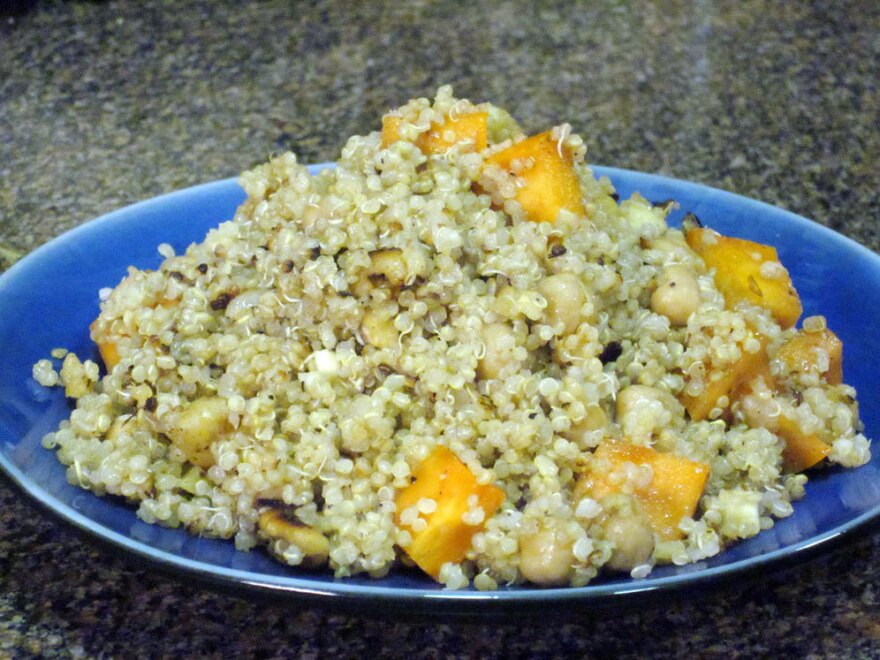The explosion in world popularity of quinoa in the past six years has quadrupled prices at retail outlets. But for all the demand from upscale grocery stores in America to keep their bulk bins filled with the ancient grain-like seed, almost no farmers outside of the arid mountains and coastal valleys of Peru, Bolivia, Ecuador, and Chile grow it.
But plant breeders and scientists who study the biology and economics of quinoa say that is about to change.
"We're going to see quinoa being grown all over the place soon," predicts Kevin Murphy, a Washington State University grain breeder who has spent several years developing quinoa varieties suited to America's diverse geography and climates. Murphy says it's already clear that quinoa can flourish and produce high yields in many parts of North America, and he sees "no reason why quinoa production won't take off in the next few years."

Small-scale farmers in the Northwest are currently testing the crop, harvesting a few pounds of quinoa each fall among their rows of vegetables and fruits and selling the seeds at farmers markets, but quinoa farming in the United States has not yet taken off in a big way for multiple reasons.
First, Murphy says, the quinoa craze is such a new phenomenon that farmers have hardly had a chance to react. As recently as six years ago, American shoppers could buy quinoa for the rice-like price of $1.50 per pound. Now, retailers get between $4.50 and $8 for every pound they sell of this nutrient-dense superfood.
So clearly, growing quinoa — which is actually the seed of the goosefoot plant ( Chenopodium quinoa) — could be lucrative for American farmers, though only in cooler regions. Quinoa is very heat sensitive, and experienced gardeners say temperatures of 95 degrees will completely destroy a crop. Another challenge to producing quinoa is rain. If it falls during the autumn harvest time, it can ruin the crunchy, high-protein seeds by causing them to sprout.
And then there's the problem of removing the saponin, the naturally-occurring bitter layer of compounds that deter pests, but makes uncleaned seeds all but inedible to people. Special cleaning systems would have to be set up to do this, as growers in South America have learned.
To date just one sizable operation, in the Colorado Rockies, has made a big investment in the seed. "When we first started [in 1987] there was no demand for quinoa," recalls owner Ernie New, who planted 120 acres of quinoa this May and harvested 70 after a summer of destructive weather. "Nobody knew how to grow it, to clean it, to prepare it, to eat it. There was no information at all about it." Today, New says, he receives far more orders than he can meet, many from restaurants and retailers hoping to market "locally grown" quinoa.
But for now, virtually every quinoa seed eaten in the United States is imported from South America. There, almost 80,000 tons of quinoa were harvested in 2010.

And it's not without challenges. In Bolivia, second in production to Peru, great prosperity has come to many farmers. But communities in the Bolivian Andes that formerly lived on quinoa have become unable to afford it and are now relying more on nutritionally inferior processed foods.
And property disputes are reportedly on the rise as South American entrepreneurs — often landless arrivals from the cities — compete with one another for growing space in the limited arable land of the Andes as they try to cash in on the quinoa craze. Bolivian llama herders are also abandoning their flocks, once the region's natural fertilizer source, and, instead, planting quinoa. This seems already to be causing declining soil productivity.
Most South American quinoa farms are at high elevation — some more than two miles above sea level—but quinoa is a highly adaptable and versatile species, according to Oregon nurseryman Frank Morton, owner of near Portland.
Morton has been growing and breeding quinoa since 1984. Heat and moisture remain frequent killers of most varieties, but through selective seed saving, Morton has transformed several original types of quinoa into at least five new ones that he says can thrive in North American climates "and produce great yields on terribly poor soil." He has seen quinoa plants freeze solid overnight and continue growing after thawing — making it a potential crop for mountainous regions where other fruits, grains and vegetables cannot be grown. He also has seen it grow at sea level.
Morton believes that the Rocky Mountains, much of Canada, and the Pacific Northwest all have potential as quinoa producing regions, and he says he's certain that a North American quinoa industry will soon boom.
"There is tremendous potential for quinoa," he says. "The key is simply figuring out where it will grow."
Copyright 2020 NPR. To see more, visit https://www.npr.org.


